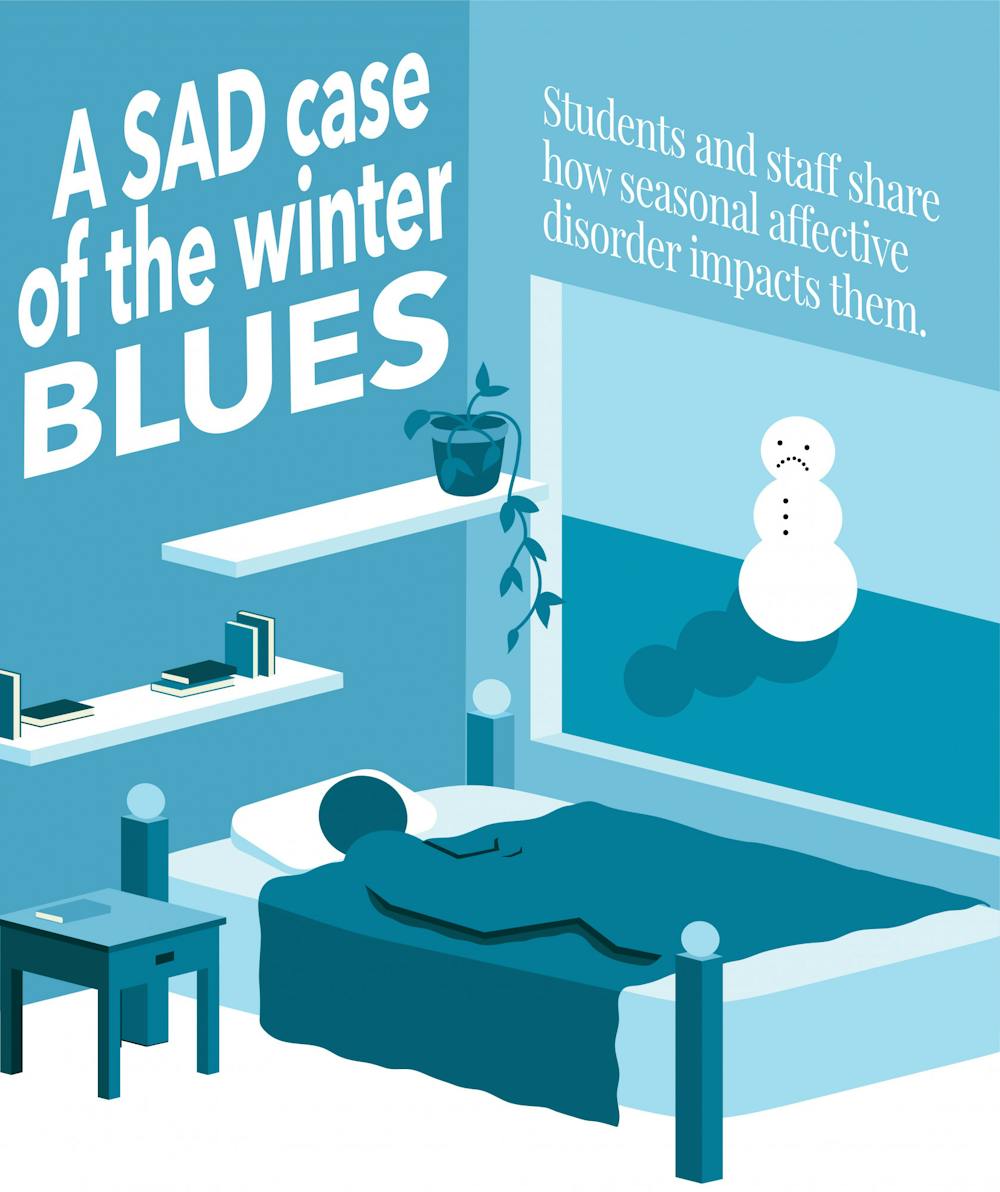Editor's Note: An earlier version of this article misrepresented where Emotional Support Animals (ESAs) are allowed to be. The article has since been updated.
Thin air. Colder wind gusts. Shorter days. Changes in sleeping. Increased anxiety. Social isolation. According to Healthline, an estimated 10 million Americans suffer the mental health issues associated with winter.
Seasonal Affective Disorder (SAD) is a mental disorder connected to the change in seasons. While all seasons can impact mental health, winter triggers SAD most often, Betsy Varner, Ball State University postdoctoral fellow, said.
“[SAD] is the cluster of symptoms that someone experiences at the onset of a certain time period during the year,” Varner said. “[SAD symptoms] come towards the end of fall, through winter and then improve in the spring and summer. It goes along with the seasons and with the weather patterns as well.”
One aspect of winter is the sun setting an hour earlier than in the spring or summer, which can make the days seem shorter. Aubrey Driscoll, Ball State Counseling Center associate director for prevention and wellness, said sunlight has a strong impact on the body. Sunlight inhibits the production of melatonin from the pineal gland. With the lack of sunlight during the winter, people may find themselves sleepier during the day.
“It may be difficult to get out of bed, [and you] may be [finding] yourself feeling really tired or needing to sleep more often,” Varner said. “Maybe [it's] harder to do things throughout the day and keep that energy up. Sleeping too much is definitely something that’s common, especially during the winter months where SAD is present.”
Jodie Burns, second-year Ball State visual communications major, said she has been affected by SAD for seven years. She said her SAD symptoms begin at the start of fall, and not only is her sleep affected, but she said her personal hygiene is not a huge priority during the colder months.
Driscoll said other symptoms of SAD include feeling down most of the day, losing interest in typically enjoyable activities, difficulty concentrating, feeling worthless and/or hopeless, losing or gaining appetite and, in severe cases, feeling suicidal. Driscoll said these symptoms can arise from more than just the sun or the temperature.
“In the colder months, sometimes, [these symptoms] could be due to some struggles around SAD,” Driscoll said. “But then there’s also concerns around navigating the holidays, finals and midterms.”

Snow falls on the rooftops of campus buildings Feb. 8, 2021 from the top of Teachers College. Rylan Capper, DN
Burns said her academics are strongly affected by SAD because it is difficult for her to focus on her work. First semester finals occur during the middle of December, which Burns said can contribute to SAD.
“In any instance, whether you are mentally sound or not, finals take a toll on your mental state,” Burns said. “Whether you have depression or you don’t have depression, if you have ADHD, if you have bad anxiety, if you struggle with stress, [finals] can amplify anybody’s mental state to a stage of not wellbeing, but it [especially] doesn’t help with anybody who has SAD because of the stress of it all.”
Varner said college students have many things on their plates, like newfound responsibility, which can be stressful and exhausting to manage. She said part of dealing with the symptoms of SAD is by establishing a consistent and healthy daily routine.
“College students oftentimes have a really hard time keeping a regular routine anyways because sometimes [they] have an 8 a.m. class, sometimes [they] have to stay up until 2 a.m. studying,” Varner said. “[That schedule] makes it really hard to keep [a] routine, but having a routine can be really helpful to manage some of these [SAD symptoms].”
Driscoll said having a support system on campus can greatly help with managing mental health issues like SAD. She said engaging in on-campus activities and utilizing Ball State’s Counseling Center can be where these support systems are found.
Burns said her depression in high school contributed to her feeling suicidal. When she talked with her mom about how she was feeling, her mom entered a suicide awareness giveaway from a dog breeder.
She and her mom drove to the breeder's house, where Burns was surprised with a Goldendoodle puppy. Burns could decide on two different names belonging to people who died from suicide, and she picked “Skylar.” Since having Skylar, Burns said she has been getting progressively better.
“I really do think animals help a lot [with mental health],” Burns said. “My friend has an emotional support animal (ESA) — a cat. She’ll be crying, but she’ll be cuddling up with that cat, and it helps relieve stress."
Burns said she recommends getting an ESA, or a pet, to anyone who struggles with mental health issues.
Other ways to manage SAD symptoms, Varner said, is by being proactive and knowledgeable about how late fall and winter can impact mental health. She said discussing potential medications and supplements with a medical provider can help battle some SAD symptom concerns.
“Setting up social support, letting friends and family know, ‘Hey, winter [is] really hard for me, and I might need some help during this time,’ [can prepare you for SAD],” Varner said. “Other things to think about would be getting as much sunlight as you can. On those rare sunny days in the winter, even though it’s cold, that sunlight really does have an effect on our bodies. Also, being able to move your body and maintaining a balanced diet helps regulate the serotonin levels in our bodies, [and it will] help regulate some of those [SAD] symptoms that come.”
Contact Maya Kim with comments at mayabeth.kim@bsu.edu or on Twitter @MayaKim03





The Daily News welcomes thoughtful discussion on all of our stories, but please keep comments civil and on-topic. Read our full guidelines here.